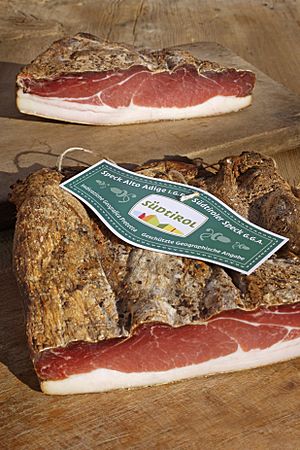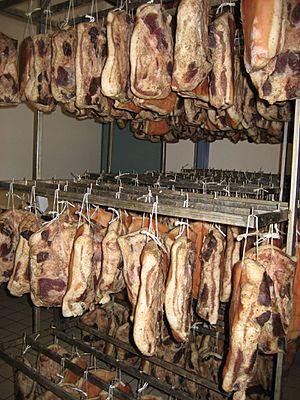Speck facts for kids
Speck is a type of meat product, usually made from pork. It's often smoked or cured, which means it's preserved with salt and other ingredients. Depending on where you are in the world, "speck" can mean different things. For example, in Germany, it often refers to pork fat, sometimes with a little meat. But in places like Italy and Turkey, "speck" usually means a special kind of smoked ham called South Tyrolean speck. The word "speck" became popular in the 1700s, taking the place of an older word, "bachen," which is related to "bacon".
Contents
Different Kinds of Speck Around the World
Many countries have their own unique versions of speck. These types often have special flavors and ways of being made.
European Speck Varieties
- Bacon is a well-known type of speck. In Germany, you might hear of Frühstücksspeck, which means "breakfast speck."
- Gailtaler speck comes from Austria. It has a special status called PGI (Protected Geographical Indication), meaning it can only be made in the Gail Valley. People have been making it there since the 1400s!
- Guanciale is an Italian type of cured pork, often used in pasta dishes.
- Lardo is another Italian specialty. It's made from cured pork fat and comes in many different kinds.
- Pancetta is also from Italy. It's a type of pork belly that is cured, but usually not smoked.
- Schinkenspeck is a German "ham bacon." It's typically made from a flat cut of ham with a layer of fat. It's often soaked in salty water with juniper berries and peppercorns.
- Speck Sauris PGI is a special speck from Sauris, a town in Friuli, Italy.
- Speck Alto Adige PGI is a very famous speck from South Tyrol, a region in Italy. It's known for its unique smoking and curing process.
- Tyrolean Speck is from the Tyrol region in Austria. It also has PGI status and has been made since at least the 1400s.
- Ukrainian salo is a traditional Ukrainian food, often made from cured pork fat.
- Proshute is the Albanian version of speck.
Speck in Jewish Deli Food
In Ashkenazi Jewish cooking, pork products like bacon are not allowed because of kosher food rules. So, when people talk about "speck" in this cuisine, they are usually talking about the fatty part of a beef brisket. This beef "speck" is a special part of Montreal-style smoked meat sandwiches. Slices of this fatty beef are served on rye bread with mustard, sometimes mixed with leaner cuts of meat.
See also
 In Spanish: Speck para niños
In Spanish: Speck para niños



